Slaughterhouse Workshop, Part 2
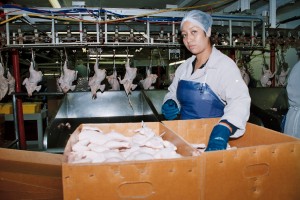
Text and photographs by Thomas Sayers Ellis.
Commentary and poems by Jennifer Fitzgerald.
Part 1 can be found here.
That first day of shooting I was impressed by everything I saw, especially the hanging hooks and other machinery, such as trucks and forklifts and tools—the numerous silver things from another century that I couldn’t name. If I let my imagination crawl, the whole environment was one big controlled, atmosphere of torture.
Holster filled with sharpened blades.
Meat hangs, menacing on hooks—
stacked like pine trees,
branches splayed.
I made sure that I had three cameras—one loaded with color film; the other, b/w, and a digital camera just in case. I bought along a flash but challenged myself to only use it when absolutely necessary. I had to wear a long white coat and something to keep my hair covered while on the floor. The smell did not rush out to meet me. I stepped into it and it digested me—one exposure and a time—and lasted, my body in it, for the next three days. Even now when I see the images, my senses are transported back to the moment the photographs were taken, sharply. I am where I have been.
That smell is blood,
connective tissue slapped on the floor,
primal fluid, your pulse raised
like a teaspoon of adrenaline, fades
but instinct lingers
like the fat clogging
your sole’s gaps.
As I walked slowly through the cold, wet warehouse, my body remembered being photographed by Bruce Weber for Interview Magazine with the caption “Literary Activist.” I sensed that I was now in the same building or in a building very close to the one I was in 1994. This would not be the last time that I would feel a sense of time travel while working with Local 342. Everything I knew about photography, poetry and cinema were colliding. Years ago Weber sat me on a bed and photographed me as a team of boy-photographers passed him, as if in a bucket line to put out a fire, different cameras and different camera backs. Weber wore a bandana and barked out audibles, changing the visual playbook at the line of scrimmage like Peyton Manning, often, without even looking back at his team of helpers. He didn’t take his eyes off of me, not once, during the shoot. My body could feel it. I was near it, 1994, but where were my boy-photags. When Jennifer tried to help, she accidently exposed a whole roll of Porta 120mm film. Damn poet.
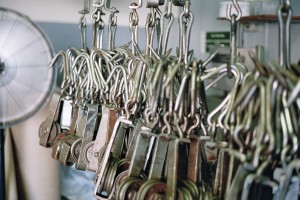
[Jennifer]
The subject sees the camera, the photographer redefines the subject and I stood, a spectator of observation and discovery; all thumbs with a roll and a manual wind. I tried to line it up, tried not to let on that it was my first time.
I felt like a baker, dressed the way I was dressed. I could sense things rising, falling, movement I could not see. The floor was slippery and someone was using a water hose. The workers were often ghosts of themselves, the rivals of silhouette in steam and heat. I thought to myself “Damn, all of the photographs will look like they were taken in a dream.” Between precise rows of cows, I walked, more so to let the workers see me being casual and to get them used to seeing me.
A Picasso carved
from a side of beef.
Take hands to aerial knife,
swipe, shoulder-slice
tissue, disconnect; reestablish
bond with flesh.
I crouched my camera bag to my gut like a pigskin and dashed between the dark and bright slaps like I was breaking lines and splitting shank portions into metaphors. My audience was meat, “Hog Butcher for the World,/Tool Maker, Stacker of Wheat,…” mixed with Cornbread, Earl and Me with a respectful nod to Upton “Incognito” Sinclair. Self-trained as a creative writer, I couldn’t stop thinking creatively, so all of that (and then some) flooded my mind.
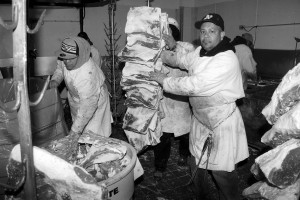
Tolerated. I stood next to the butchers, balancing listening and shooting. The knives were sharp, medium format sharp, sharp and silent, so silent they made a revision of air, a skill the meat obeyed.
Cut, scrape, move to the left.
Cut, scrape, move to the left.
Bone fragments fleck
off protective glasses.
Repeat swerves,
sleights of hand.
Cut, scrape, move to the left.
They joked with each other about appearing in photographs and a few of them refused to be photographed saying they didn’t want to be found. There was the occasional disagreement and stabbing, humans. I learned quickly to distinguish from their eyes who would allow me to photograph them and who would not. I did not give any one particular worker more attention than another, and despite all of the blood, plastic barrels of animal fat, and the side-by-side breathing of men and women, I could not stop feeling like I was inside the brick stomach of a huge machine—pulleys, conveyor belt-like intestines, large vats and bins of stripped bone. Stanzas, lines, words.
Captive bolt pistol hacks, hisses,
heaves cow to the floor.
Hook the hooves and invert bodies;
suits on a motorized line.
The killing floor is slick.
So often the poem on the workshop table is treated like a dead body undergoing an autopsy. By cutting into the poem the instructor identifies the various causes of death—a lack of structural integrity, kidney failure. Overwhelming narrative behavior, pancreatic cancer. Soon, in the bedpan next to the bed of the poem-patient, persona. Open tradition surgery, the bypassers. The stitches left on the poem-body by the removal and insertion of the tumors of reference, malignant lumps of info-knowledge held together by the nuts and bolts of slightly rhythmic linearity and pre-packaged bald patches of observation, creative junk food. At the residency of Medical Fine Arts, the bypassers are also spreading their series-viruses to the Race Erasers who, in turn, take delight in turning the various forms of their own Blues, cleverly so, into soul-less mechanisms where nothing but moderate formal structures and the wrong-headed performance of paper freedom grows. Like Health(can’t)Care, so much of today’s verse-shop-worse will do anything to its own limbs to be seen not heard.
At the beginning of every semester I say “Please don’t bore me and I won’t bore you.” At the end of the Spring semester I used to jump up on the workshop table and do a few seconds of the James Brown and end it by dropping down onto the table into a half split in front of the whole class. My gift to them, my work against tradition-thinning, my way of relieving my own tension and of removing the word “tension” from our workshop discourse, why, because its usage reminds me of appendicitis. When I teach low-residency, I line edit as a way of creating a conversation with the poem, not the poet, even though I will address the poem by the poet’s name. Much of the problem, I pretend, is the poem’s fault. The poem cannot hold poetry. The working poem is either underworked or overworked but they all work somewhere in the world. There is no such thing as an unemployed poem but there are poems that refuse to hire certain poetics and, often, any form of poetics at all. What follows is one of Jennifer’s MFA poems and TSE’s line comments, followed by Jennifer’s sass to TSE’s razors.
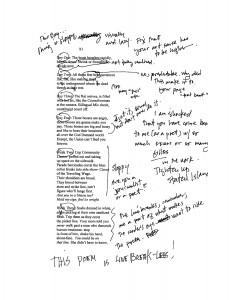 <
<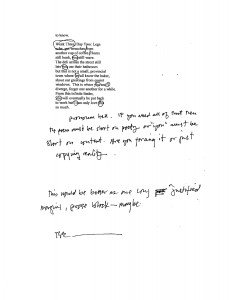
This damn thing is sloppy visually, and lazy…fix that. Your sense of art needs to be higher.
I’m shaping this from a bucket of trimmings. We aren’t taught to make art from labor. Art is marble not marbled flesh. If I reject this premise, I am creating a new alphabet to get my words right.
I am shocked that you have come back to me (as a poet) with so much excess or so many fillers in the work. Tighten Up Staten Island
I can’t help that those other voices sliced my syllables sideways. Tow the line or get the ice. But this line isn’t just creative, it breaks ten different ways. They don’t let unions organize MFA Programs.
Sloppy, are you a journalist or a poet?
These two have to meet and diverge somewhere—amicably or not. The images ride me, I can’t shake them. Grind them into the page or my body absorbs them. The weight is tremendous and I can’t move [them out].
The line breaks, remember, are part of what makes the reader’s eye want to ride the poem. THIS POEM IS LINE BREAK-LESS!
Remember, I remember but when sparring the page, I forget. Bob and weave my own rhetoric to get to the gold-laced prosody. It’s there, I’m learning, I can almost see it. I know you want to push me past myself, but Thomas, this clock punches back.
Pronoun Hell. If you need all that, then the poem must be short on poetry or “you” must be short on content.
It isn’t the content, it’s the reader. The reader can’t see the shit I’ve seen. They want Greek gods and fables, I have connective tissue and sweat. If it is “he,” they can breathe, if it is “we,” they still have space, once it is Dear Reader, here is the foul underbelly of the earth, they run from me.
Are you just copying reality?
Whose reality? When you say this life can’t be art, this transcribing of breath can’t beat the drum of prosody, you lie to yourself about what these people need, these readers and muses. To bring bodies to poetry, glorify them.
***
Somewhere there is a photograph of me standing on top of a wooden picnic style bench photographing two tired workers who are on their lunch break (Jennifer took it). One of the men is sitting up about to eat and the other is fully stretched out on in his back on the long sitting side of the bench, exhausted. The photograph was taken outside of a chicken processing plant in Upstate New York during a long day of shooting the interior and exteriors of the plant as well as in the homes of selected workers.
The Ask: We just want quiet, a labor force
of yes, American Dream, day dream,
dream a little dream, old time religion,
don’t stop believing, muscle, sports,
madness, spit shined, moon shined,
good-natured consent. The Get: This.
Robert Capa said, “if your photographs aren’t good enough, you are not close enough.” I believe this is also true of poetry. I believe that the overuse of sight (and only sight at the expense of the other senses) limits the chances of smell, hearing, taste and touch of becoming organic-technical devices in contemporary poetry, and creates more distance than intimacy, distance-looking like distance-learning, a sort of “hospital lighting” of precision devoid of non flatness, devoid of da phat work. I carry a silver, coiling gooseneck lamp to low-residency and the worksites, asking the workers and faculty and students to have their portrait taken under the lamp. Instantly a locker room or empty classroom is turned into a mini photographic studio. A bag of cameras, table, lamp, two chairs, photographer, worker, and Jennifer watching, silently in a corner ushering in worker after worker. Eventually work poems and their difficult, stubborn births began to pass through her entire body, one Strike Captain at a time.
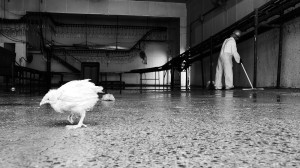
The light from the lamp, when positioned properly, eliminates the entire background and makes the subject both illuminous and realistic, close to the skin, hot. At the chicken processing plant, I left three rolls of exposed film in the work coat I was given to wear on the main floor and, later, the coat was tossed into a large, industrial washing machine. The chickens arrived in cages in a long truck and were hung upside down and de-feathered by what I can only describe as a skeletal terza rima, perhaps one of Dante’s drum machines. The smallest one, being too small to be clasped, marched away in its own rhythm. Worker, workshop, the connections forced themselves into my lens because the art of losing is there too; and, later, in the car next to me, the wet face of a poet.
Processing Plant, So. Fallsburg, N.Y.
Perpetually a few shudders
from ecstasy, the building vibrates
its death in puffs of pulverized
bone and undercoat. Shuffling
in galoshes, cowl-eyed, they move
from locker to glove, to knife;
ankle grab at conveyor belt
of fluttering. Behold the mechanism
that feeds the blade throats.
By noon, thin pink fills blood room.
Migrant, immigrant, emigrated-
boot cover hooves clomp moist cement.
USDA countdown of freshness punctuates
shifts by stages of decay, flicks
worker ears in native tongue.
Dress yourself, feed machine, breathe,
eat, dress poultry, breathe, divvy down
to wing and breast, breathe, wrap
in cellophane. 10,000 chickens;
overseers set watches to sundown.
300 workers keep unconscious calendars,
know Holy Shabbat by vacancy. 24 hours.
Goliath must not, I repeat, must not rest.
Dressed trucks, live trucks line the lot.
Plastic pallet stacked chickens jockey
for an inhale, flinch at fileted breasts
passing their periphery. One spare
feathered baby slips free from ankle
clasps, pecks at her own massacre,
hosed down, down the drain.
Thomas Sayers Ellis grew up in Washington, DC, and earned his MFA from Brown University. He is the author...
Read Full Biography

